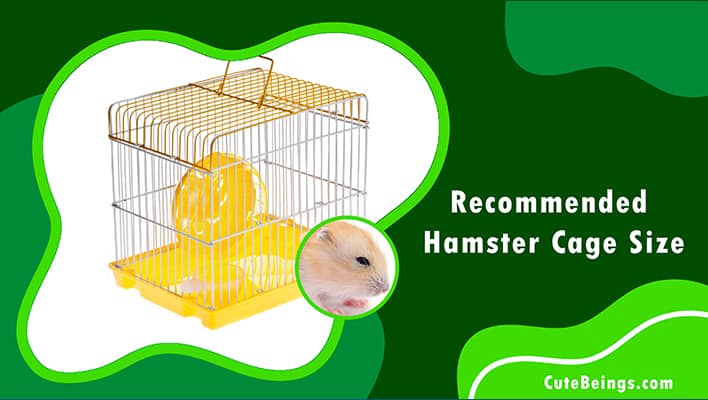Hey there, fellow hamster owners! As a long-time hamster care specialist, I know how important it is to make sure your little furball has the best home possible. That’s why today we’re here to talk about something that’s essential: finding the right cage size for your pet.
Choosing the correct habitat size can be tricky if you don’t have all the information needed – but don’t worry, we’ve got you covered! In this article, we’ll discuss some basics of recommended sizes as well as provide tips on picking out the perfect one for your adorable pal. This way, you can ensure they get enough space and enrichment in their environment.
Table of Contents
What is the recommended hamster cage size?
When it comes to hamster cage size, there is a recommended size that many experts agree on. Many owners may not be aware of what this advised dimension is for their pet’s environment, but luckily, there are guidelines and standards in place to ensure the best possible housing situation for our furry friends. The recommendation for an ideal hamster cage size can range from 24” x 12” to 30” x 14” including both width and length.
Though these dimensions may vary slightly depending on the type of hamster breed you own, they will typically fall within these ranges when following the standard guidelines set forth by reputable specialists.
What is the Rspca minimum hamster cage size?
The RSPCA (Royal Society for the Prevention of Cruelty to Animals) has set a minimum cage size recommendation for hamsters. For Syrian hamsters, the recommended floor space should be at least 80cm x 50cm. The height should be no less than 30 cm and any accessories such as shelves or ramps must also fit within this area. Dwarf hamsters can live happily in slightly smaller cages but still require a minimum of 60 cm x 30 cm with a height of 20 cm.
It’s important to remember that these are only the absolute minimum sizes, so if you have the space then it is worth giving your little friend as much room as possible! A larger enclosure will give them more opportunity to explore and play, leading to healthier and happier pet.
Can hamsters survive in a small cage?
Most people are unaware of the minimum size requirements for a hamster cage. It is vital to understand that while they may appear small, these furry friends still need plenty of space to stretch their legs and explore. German dwarf hamsters have been reported as capable of living in cages as small as 30 cm long, but this is not recommended because it does not provide enough room for them to live comfortably.
Hamsters will eventually succumb to stress if placed in a small cage without adequate vertical height or length which can lead to health problems and even death. Therefore, it is important to be aware of the risks associated with having an undersized enclosure when looking into getting a pet hamster.
Do hamsters like big or small cages?
When it comes to hamsters, cage size is an important factor. Most experts recommend a minimum of 360 square inches for small breeds and 600 square inches for larger breeds. A big enough cage allows the animal plenty of space to exercise and explore. On the other hand, a large or too small hamster cage can be overwhelming for them as well.
Hamsters are comfortable in smaller cages, but bigger enclosures allow more room for activities such as running on their wheel, playing with fun toys, and climbing over structures like ladders or tunnels. To ensure that your pet has adequate living space, you should measure the length and width of the floor area before purchasing any supplies. It’s also essential to provide sufficient ventilation: make sure there are no sharp edges, gaps between bars, or overcrowding inside the enclosure.
What happens if a hamster cage is too small
If a hamster cage is too small, it can adversely affect the animal’s health. A hamster needs room to move around and explore, so having an environment that restricts their movement can be damaging. Small cages have limited air circulation which can lead to respiratory problems and other issues like overheating. Additionally, too-small cages may not give your pet enough space for toys and activities necessary for them to stay entertained and healthy.
Cage size danger should always be taken into consideration when selecting a home for your hamster. It’s essential to get one of appropriate size based on the type of hamster you have as well as its individual size requirements.
Syrian Hamster Cage Size
When it comes to Syrian hamsters, cage size is incredibly important. If you are considering getting a Syrian hamster, then you need to make sure that their home is the right size. The minimum size for a cage designed specifically for Syrian hamsters should be 8 square feet. this allows them plenty of space to move around and explore their environment. To give your pet more room, I would recommend opting for much larger cages or even custom-built enclosures!
Dwarf Hamster Cage Size
When it comes to dwarf hamsters, there are a few different species, including the Russian dwarf hamster and the Chinese or winter white dwarf. For these little critters, cage size is an important factor in keeping them happy and healthy. A good minimum size for one of these dwarf hamsters is 18” x 12” x 14”. This will provide enough space for your pet to explore, exercise, and play while providing ample room for nests, toys, hideaways, and other enrichment activities.
If you choose to house two dwarf hamsters together, such as when caring for a pair of German Dwarfs, then the minimum recommended size should be 24″x12″x14.” Bear in mind that this would need to be bigger if you plan on having more than two in the same enclosure. With any type of hamster cage size, make sure that your pet has plenty of ventilation with no drafts coming through so as not to affect their health adversely.
What size cage for winter white hamster
When it comes to the cage size for winter white hamsters, there are a few important things you should consider. First and foremost, these little critters need plenty of space to move around in order to stay healthy and happy. A single adult winter white hamster will require a minimum cage size of 24 inches by 12 inches, but larger cages are always better. It’s also important to make sure that your hamster has enough room for exercise equipment such as wheels and tunnels so they can get the activity they need each day.
For two or more winter whites living together, the recommended cage size is at least 36 inches by 18 inches, with ample opportunity for them to climb, explore, and play. Having extra levels within the cage is an excellent way to provide them with additional stimulation while allowing them plenty of privacy when needed. With a suitable sized environment like this, your winter whites will be able to live happily and comfortably without feeling cramped or overwhelmed.
How much space does a russian hamster need?
When it comes to the housing of a Russian hamster, their cage size can vary depending on how much space they need. As with all hamsters, providing plenty of room and lots of different areas for them to explore is key to keeping them happy and healthy. A good rule of thumb when deciding what size cage your Russian hamster needs is that one cubic foot should be provided for every inch or so of body size. So if you have a large russian hamster, then you will want to look at cages that are around 20 to 30 inches long by 12 to 15 inches wide, as this provides enough space for him or her to move around easily.
You’ll also want to make sure there are several levels within the cage, such as shelves, ledges, tunnels, and exercise wheels; these will help keep your little buddy entertained and active while helping them stay fit and healthy too! When adding items to their environment, remember not to overcrowd the space; provide sufficient room so they don’t feel trapped or overwhelmed by their surroundings.
What size cage for hamster in germany
When it comes to the recommended size of hamster cages in Germany, the guidelines are quite similar. Generally speaking, any cage intended for a winter white hamster or other species of hamsters should provide an absolute minimum floor space of around 1000 square centimeters per animal. Of course, larger is always better when it comes to keeping your pet happy and healthy. The more room there is for them to play, explore, and exercise, the better!
In addition, German standards recommend that any cage used for housing a hamster also have at least one “hideout” area (e.g., a small plastic hut) as well as plenty of substrate material such as wood chips or shredded paper so that they can build their own nests. This will help keep them from becoming stressed out due to overcrowding and/or a lack of stimulation while in captivity.
What is the minimum hamster cage Uk?
Now that we’ve discussed what size cage a hamster needs in Germany, let’s take a look at the minimum requirements for a hamster cage in the UK. When it comes to finding a suitable cage for your furry friend, there are several factors to consider. Here is an overview of the essential information you need when deciding on the best size for your pet:
- * **Cage Size UK** – The recommended minimum size for any hamster cage in the UK should be 120 x 60cm (4ft x 2ft). This will provide enough space for them to move around and play comfortably.
- * **Hamster Size UK** – Generally, adult Syrian or Dwarf Hamsters can grow up to 15-17cm long so they will require more room than baby ones which only reach 8-10 cm once fully grown.
- * **UK Minimum Size** – To ensure your pet has plenty of room and stimulation, try aiming for something larger than what’s stated as the bare minimum such as 150 x 80cm (5ft x 3ft) if possible.
When shopping for a new home for your little one, make sure you opt out of anything too small as this could lead to negative health effects like stress or injury due to lack of exercise or being cramped inside their living quarters. On that note, let’s now discuss some common mistakes people make when choosing a hamster cage, including going with something far too tiny!
Frequently Asked Questions(FAQ)
Too small hamster cage
When it comes to hamster cages, size really does matter. A too-small cage can have serious implications for a hamster’s health and well-being. Hamsters need plenty of space to move around, explore, and exercise in order to stay active and healthy. Therefore, the minimum recommended size for a hamster cage is 24″ by 12″. If your cage is any smaller than this, it may be affecting your pet’s quality of life.
Conclusion
As a hamster care specialist, I cannot stress enough the importance of getting the right size cage for your pet. A hamster requires plenty of space to move around and exercise in order to stay healthy and happy. For this reason, it is important to ensure that you provide them with an appropriate-sized enclosure that meets their needs.
The recommended minimum size for a hamster cage is 6 square feet, or approximately 3 feet by 2 feet, but much larger cages may be necessary depending on how many hamsters will be living together. If you opt for something smaller than this, you run the risk of having an unhappy and unhealthy pet who feels cramped and uncomfortable in its surroundings.

Hello, my name is James and I’ve been caring for tiny pets for over 14 years with a passion. I enjoy passing on my expertise to other individuals in order for them to have the same amount of enjoyment as I do.




